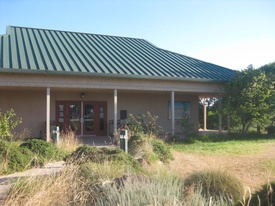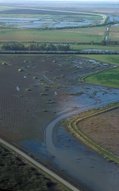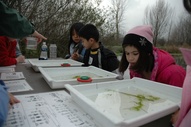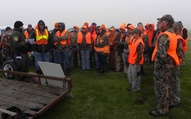
 Yolo Bypass Wildlife Area Headquarters.
Yolo Bypass Wildlife Area Headquarters.
The Yolo Bypass Wildlife Area is located within the Yolo Bypass in Yolo County, California. The Wildlife Area is managed by the California Department of Fish and Wildlife with the intent of restoring and managing a variety of wildlife habitats in the Yolo Basin, a natural basin in the north part of the Sacramento-San Joaquin River Delta. The creation of the Wildlife Area was spearheaded by the Yolo Basin Foundation. The California Department of Fish and Wildlife and Yolo Basin Foundation are the core partners in the operation of this unique community resource.
History
The Wildlife Area was open to the public in 1997 after extensive restoration efforts completed by Ducks Unlimited with federal funds appropriated through the United States Army Corps of Engineers. In 1999, this 3,700-acre (15 km²) restoration project was named the Vic Fazio Yolo Wildlife Area in honor of congressman Vic Fazio who lobbied hard for the funds needed to build the project. In 2001 the Wildlife Area expanded to over 16,000 acres (65 km²) with the acquisition of the Glide and Los Rios properties. These acquisitions included the 10,000-acre (40 km²) Tule Ranch, a working cattle ranch with extensive vernal pool areas.
Flood Control
The Yolo Bypass is a 59,000-acre (240 km²) flood control channel that protects Sacramento and other cities from flooding. The Wildlife Area was created with the understanding that it would remain completely compatible with this primary flood control function. For this reason, there are restrictions on the density of emergent vegetation and riparian trees within the Wildlife Area. These standards are determined through the use of hydrologic models.
Located at the north end of the Yolo Basin where Putah Creek enters the Yolo Bypass, this part of the Delta is known as the Putah Sinks and hosts a diverse assemblage of wildlife species inhabiting seasonal wetlands, permanent wetlands, riparian forest, uplands, vernal pools and agricultural habitats. This area remains as a critical link in the complex chain of habitats that make up the Central Valley wetlands, a critical part of the Pacific Flyway.
Wildlife Habitat Types
Seasonal Wetlands  Seasonal Wetland during spring drawdown. Most wetlands on the Wildlife Area are managed as seasonal wetlands. They go through an extensive dry period during the spring and summer months. Typically these ponds are drained April 1st to stimulate the germination of Swamp Timothy. They may receive a brief summer irrigation and then are flooded in September to provide wetland habitat for migratory waterfowl and shorebirds. Because of its low stature, Swamp Timothy provides little resistance to flood flows, thus preserving the primary flood protection purpose of the Yolo Bypass. Additionally, this plant produces small seeds for waterfowl and a suitable substrate for the production of invertebrates, an important food source for shorebirds.
Seasonal Wetland during spring drawdown. Most wetlands on the Wildlife Area are managed as seasonal wetlands. They go through an extensive dry period during the spring and summer months. Typically these ponds are drained April 1st to stimulate the germination of Swamp Timothy. They may receive a brief summer irrigation and then are flooded in September to provide wetland habitat for migratory waterfowl and shorebirds. Because of its low stature, Swamp Timothy provides little resistance to flood flows, thus preserving the primary flood protection purpose of the Yolo Bypass. Additionally, this plant produces small seeds for waterfowl and a suitable substrate for the production of invertebrates, an important food source for shorebirds.
Permanent Wetlands  Permanent Wetlands are deeper and flooded year round.
Permanent Wetlands are deeper and flooded year round.
Permanent wetlands are flooded year round and tend to be deeper and have more emergent vegetation. These ponds provide important brood water for resident aquatic birds such as mallards, common moorhens and pied-billed grebes. They also provide drinking water for wildlife as well as relief from intense summer heat. This habitat is used extensively for roosting by black-crowned night herons, egrets, and white-faced ibis. The Giant Garter Snake also occurs in this habitat.  Upland habitats on the Tule Ranch
Upland habitats on the Tule Ranch
Uplands
Upland habitats are used extensively by ground nesting birds such Northern Harriers, Western Meadowlarks, Mallards and Ring-necked Pheasant. Vegetation is typically dominated by annual rye grass, curly dock and wild sunflower. Typically, legumes such as vetch or various clovers are planted to increase the value of this habitat for nesting birds. Late spring irrigations through parts of the uplands can substantially increase the chick survival of Ring-necked Pheasant while increasing the occurrence of passerines such as Blue Grosbeak and Western Meadowlark. Rodent populations in these areas provide prey for large numbers of wintering birds of prey. As rodent populations increase, so do the number of nesting raptors including Northern Harriers and Short-eared Owls.
Riparian Forest  Aerial view of the terminus of Putah Creek.
Aerial view of the terminus of Putah Creek.
Riparian vegetation consists of willows, cottonwoods, black walnut and other tree species. Nesting species include Swainson's hawks, great-horned owls, wood ducks, tree swallows, and black phoebe. This habitat is very important for neo-tropical migrants such as blue grosbeak, ash-throated flycatchers, and a variety of warbler species. Most riparian vegetation is located along Putah Creek in the central part of the Wildlife Area.
Vernal Pools  Vernal Pool on the Tule Ranch Approximately 1,800 acres (7.3 km²) of natural uplands occur in the southwest portion of the Wildlife Area. There are several vernal pools in this area that are home to such invertebrate species as tadpole shrimp, clam shrimp and the endangered Conservancy fairy shrimp. Rare and endangered plants include Heckert's pepperweed and Ferris' alkali milk vetch. Grassland bird species in this area include grasshopper sparrow, savannah sparrow and burrowing owl.
Vernal Pool on the Tule Ranch Approximately 1,800 acres (7.3 km²) of natural uplands occur in the southwest portion of the Wildlife Area. There are several vernal pools in this area that are home to such invertebrate species as tadpole shrimp, clam shrimp and the endangered Conservancy fairy shrimp. Rare and endangered plants include Heckert's pepperweed and Ferris' alkali milk vetch. Grassland bird species in this area include grasshopper sparrow, savannah sparrow and burrowing owl.
Agriculture  Snow geese on grazed pasture. An interesting feature of the Wildlife Area is the extensive use of agriculture to achieve its wildlife habitat goals, while providing important operating income. Cattle are used to control unwanted vegetation and are the primary management tool in the vernal pool habitat area. Their removal of thatch from the thick stands of annual rye grass help facilitate the germination of native forbs in this area, resulting in spectacular blooms of wildflowers each spring. In the northern portions of the Wildlife Area, rice is grown, which is then flooded after harvest, attracting thousands of waterfowl and shorebirds in full view of the thousands of automobiles on Interstate 80. Wildlife Managers have instituted a unique rotation within the rice fields that allows for a fallow stage every three years. During this fallow stage, the field is managed for migratory shorebirds by flooding during the mid summer months.
Snow geese on grazed pasture. An interesting feature of the Wildlife Area is the extensive use of agriculture to achieve its wildlife habitat goals, while providing important operating income. Cattle are used to control unwanted vegetation and are the primary management tool in the vernal pool habitat area. Their removal of thatch from the thick stands of annual rye grass help facilitate the germination of native forbs in this area, resulting in spectacular blooms of wildflowers each spring. In the northern portions of the Wildlife Area, rice is grown, which is then flooded after harvest, attracting thousands of waterfowl and shorebirds in full view of the thousands of automobiles on Interstate 80. Wildlife Managers have instituted a unique rotation within the rice fields that allows for a fallow stage every three years. During this fallow stage, the field is managed for migratory shorebirds by flooding during the mid summer months.
Public Use
 Large numbers of waterfowl on the auto tour route. The Wildlife Area is open every day (except Christmas) for wildlife viewing and fishing. October through June, there are monthly tours on the second Saturday of each month conducted by volunteers from the Yolo Basin Foundation. Other public use opportunities are provided by the Yolo Basin Foundation and Fish and Wildlife including bat tours, open houses, and a fall/winter speaker series. Information regarding these activities can be found on the Yolo Basin Foundation website http://www.yolobasin.org. A six mile auto tour loop is open every day. This road travels through seasonal wetlands, permanent wetlands, uplands and agricultural areas. Especially during winter months, this route offers excellent wildlife viewing opportunities. Please park in turn outs and marked parking lots to enjoy hiking through this extensive wetland complex.
Large numbers of waterfowl on the auto tour route. The Wildlife Area is open every day (except Christmas) for wildlife viewing and fishing. October through June, there are monthly tours on the second Saturday of each month conducted by volunteers from the Yolo Basin Foundation. Other public use opportunities are provided by the Yolo Basin Foundation and Fish and Wildlife including bat tours, open houses, and a fall/winter speaker series. Information regarding these activities can be found on the Yolo Basin Foundation website http://www.yolobasin.org. A six mile auto tour loop is open every day. This road travels through seasonal wetlands, permanent wetlands, uplands and agricultural areas. Especially during winter months, this route offers excellent wildlife viewing opportunities. Please park in turn outs and marked parking lots to enjoy hiking through this extensive wetland complex.
Birding The Yolo Bypass Wildlife Area has become one of the premier birding areas in Northern California. Large numbers of waterfowl can be viewed in the winter months in both wetlands and flooded agricultural areas. They are often in the vicinity of shorebirds, many of which have traveled from the Arctic Coast to spend the winter in the Central Valley. The winter bird population also includes a wide variety of raptors. These birds of prey include Red-tailed Hawks, Rough-legged Hawks, Peregrine Falcon, Praire Falcon, Merlin, Cooper's Hawk, Sharp-shinned Hawk and White-tailed Kite. Bird numbers peak from December to March, when the northbound migration is in full swing. Many ducks are moving north in March, with shorebird migration peaking in mid April. At this time, birds from subtropical areas begin moving north to spend the summer in our area. Large numbers of warblers, tanagers, flycatchers and other "neotropical migrants" can be found in the few areas with willow riparian forests.
Resident birds begin nesting in the late Winter and Spring. Ground nesting birds such as Ring-necked Pheasants, Mallards and Northern Harriers use the mix of rank upland growth from previous years and the fresh sprouting grasses and forbs for nesting cover. Black-necked Stilts and American Avocets begin nesting on the receding mud flats of the seasonal wetlands in April. The young of these species are soon observed teetering on fresh legs as they probe the mud for their invertebrate prey.
By the last week in June, shorebirds begin arriving from the far north. Specially managed fallow rice fields are flooded in anticipation of their arrival and large numbers of these birds are soon feeding and roosting by the thousands. By late July, shorebirds are joined by Mallards and Gadwall who have nested in other parts of California, and gravitated to the few remaining wetlands available to them. Soon, the Pintail and Green-winged Teal arrive and the wintering flocks once again darken the skies over the Yolo Bypass.
Environmental Education School children learning about pond critters. The successful "Discover the Flyway" environmental education program annually brings approximately 4,000 students per year to learn about wetlands and visit the Wildlife Area. This program served school children from throughout the Sacramento area, serving over 100 schools from 15 different school districts.
School children learning about pond critters. The successful "Discover the Flyway" environmental education program annually brings approximately 4,000 students per year to learn about wetlands and visit the Wildlife Area. This program served school children from throughout the Sacramento area, serving over 100 schools from 15 different school districts.
The program utilizes a 3-acre wetland demonstration area at the Wildlife Area Headquarters as an outdoor classroom. Educational activities are set up to learn about animal tracks, aquatic invertebrates, plant identification as well as social studies lessons in Native American plant use and several other activities. The students then go on a tour of the Wildlife Area to see first hand, our local contribution to the Pacific Flyway chain of wetland areas.
 Wildlife Area volunteers enjoying the winter sunset. Volunteering There are opportunities for volunteers to contribute to the environmental education and public use programs. Docents for public tours are needed as well. There is great need for volunteers to help with special events such as "Duck Days," the Tule Ranch Open House and other activities. Additionally, there are special field trips and training activities available for volunteers. For more information and to learn about volunteer opportunities at the Wildlife Area contact the Yolo Basin Foundation [3].
Wildlife Area volunteers enjoying the winter sunset. Volunteering There are opportunities for volunteers to contribute to the environmental education and public use programs. Docents for public tours are needed as well. There is great need for volunteers to help with special events such as "Duck Days," the Tule Ranch Open House and other activities. Additionally, there are special field trips and training activities available for volunteers. For more information and to learn about volunteer opportunities at the Wildlife Area contact the Yolo Basin Foundation [3]. Safety orientation given by game warden prior to the junior hunt. Hunting The Department of Fish and Wildlife operates public hunting programs for waterfowl, pheasant and mourning dove in specific areas of the Wildlife Area during the fall and winter months. Dove hunting season begins on September 1 and lasts fifteen days. Waterfowl season begins in mid to late October and usually runs through the last weekend in January. Pheasant season traditionally starts on the second Saturday in November and runs until mid to late December. Please consult the appropriate California hunting regulations for more specific information.
Safety orientation given by game warden prior to the junior hunt. Hunting The Department of Fish and Wildlife operates public hunting programs for waterfowl, pheasant and mourning dove in specific areas of the Wildlife Area during the fall and winter months. Dove hunting season begins on September 1 and lasts fifteen days. Waterfowl season begins in mid to late October and usually runs through the last weekend in January. Pheasant season traditionally starts on the second Saturday in November and runs until mid to late December. Please consult the appropriate California hunting regulations for more specific information.
More information can be found at the Yolo Basin Foundation http://www.yolobasin.org/ and Department of Fish and Wildlife YBWA webpage: https://www.wildlife.ca.gov/Lands/Places-to-Visit/Yolo-Bypass-WA
2008-03-09 22:43:09 I went to the Wildlife Area today for the first time and drove the six-mile route, stopping a dozen times to get out and walk and just listen and watch birds. It was so relaxing and quiet once we got away from the freeway traffic. The only drawback was the one or two drivers that drove faster than the speed limit (15 mph), leaving behind clouds of dust that covered us as we walked or drove. I'll go again to do more extensive walking. —robinlaughlin
2009-02-07 08:04:10 I went to the Wildlife Area yesterday to take some photos and a sign said it was affected by the biweekly furlough that's hitting all state agencies. So it will be closed Feb 20th, etc. —RonPluth
2010-01-06 18:07:40 Does anyone know about dog regulations here? Can you take your dogs walking with you in the Bypass? —CParker
I don't remember for sure, but I believe they're only allowed to the north of the first parking lot. All the areas to the south are closed. I suspect one of the signs in the area will talk about it though. — WesHardaker
According to the Yolo Basin website: "At this time bicycles and dogs are allowed only in the Causeway which is between Interstate 80 and the Railroad tracks."
2013-02-12 17:18:36 I spent some time here for the first time last Sunday. Great trip. I took my parents, who are avid bird watchers, out along the driving loop. Lots of great places to stop and look around. Incredible variety of birds. There are a few picnic tables and restrooms scattered around, so on a nice day it's easy to settle in and enjoy yourself. —TomGarberson
2013-03-13 14:57:48 We just went on the monthly (second Saturday) YBWA tour, which was led by volunteer docents Rob Floerke and Ken Ealing — and it was WONDERFUL! I've been on many a beginning birding tour, but this was the best even. Their information was clear, their stories were great. No "script-reading" for these men! Whatever was seen or found was immediately explained clearly. When that little girl came up with a duck skeleton (feathered wings still attached), I was amazed at the info that fountained out. I'd happily go on a tour with either Rob or Ken again. Hmmmm... maybe we will! See you at the next second Saturday? — LoisRichter
2016-09-18 19:21:45 CParker is correct. Dogs are only allowed north of Highway 80, between the causeway and the railroad tracks. It is important to not have dogs in the wildlife area, because they leave their sent behind and that discourages the migratory wildfowl from visiting and remaining in the area —CharlieRussell







Comments:
You must be logged in to comment on this page. Please log in.